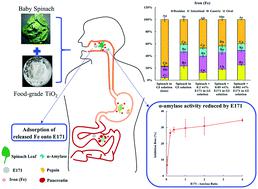当前位置:
X-MOL 学术
›
Environ. Sci.: Nano
›
论文详情
Our official English website, www.x-mol.net, welcomes your
feedback! (Note: you will need to create a separate account there.)
Food-grade titanium dioxide particles decrease the bioaccessibility of iron released from spinach leaves in simulated human gastrointestinal tract
Environmental Science: Nano ( IF 5.8 ) Pub Date : 2021-3-31 , DOI: 10.1039/d1en00064k Chunyang Li 1, 2, 3, 4 , Chuanxin Ma 5, 6, 7, 8, 9 , Heping Shang 1, 2, 3, 4 , Jason C. White 4, 10, 11 , David Julian McClements 2, 3, 4, 12 , Baoshan Xing 1, 2, 3, 4
Environmental Science: Nano ( IF 5.8 ) Pub Date : 2021-3-31 , DOI: 10.1039/d1en00064k Chunyang Li 1, 2, 3, 4 , Chuanxin Ma 5, 6, 7, 8, 9 , Heping Shang 1, 2, 3, 4 , Jason C. White 4, 10, 11 , David Julian McClements 2, 3, 4, 12 , Baoshan Xing 1, 2, 3, 4
Affiliation

|
Food grade titanium dioxide particles (E171) are added to various foods as whitening agents, including chewing gums, candies, sauces, salad dressings, and powdered milks. Salad dressings are often consumed with leafy green vegetables, such as spinach, which are rich in minerals. We hypothesized that the presence of E171 particles in foods would interfere with the bioaccessibility of essential minerals. Therefore, we investigated the impact of E171 on the bioaccessibility of minerals (Ca, K, Mg, Fe, Mn, Zn, P and S) released from spinach leaves using a simulated human digestion tract (GIT) that involves oral, gastric, and small intestinal phases. The digestive enzymes used in the GIT model, including α-amylase, pepsin, and pancreatin, prompted mineral release from spinach leaves under the simulated GIT conditions (except for Ca). E171 particles did not impact the bioaccessibility of most minerals, except for Fe. The final bioaccessibility of Fe decreased from 59% without E171 to 53% with 0.2 wt% E171. Interestingly, the decrease in Fe bioaccessibility mainly occurred within the oral phase, rather than the gastric or intestinal phases. Mechanistic studies indicated that the reduction in Fe bioaccessibility was due to the following two processes: (i) inhibition of α-amylase activity by E171, thereby interfering with Fe release from the spinach leaves and (ii) adsorption of Fe onto E171 particles. The results of this study are useful for assessing the potential impact of E171 on the human digestive process and the nutritional value of foods.
中文翻译:

食品级二氧化钛颗粒会降低人体模拟胃肠道中菠菜叶释放的铁的生物利用度
将食品级二氧化钛颗粒(E171)作为增白剂添加到各种食品中,包括口香糖,糖果,沙司,色拉调料和奶粉。沙拉酱通常与绿叶蔬菜一起食用,例如菠菜等富含矿物质的蔬菜。我们假设食品中E171颗粒的存在会干扰必需矿物质的生物可及性。因此,我们使用涉及口腔,胃和胃的模拟人体消化道(GIT),研究了E171对菠菜叶释放的矿物质(钙,钾,镁,铁,锰,锌,磷和硫)的生物可及性的影响。小肠阶段。在GIT模型中使用的消化酶(包括α-淀粉酶,胃蛋白酶和胰酶)促使矿物质在模拟的GIT条件下从菠菜叶中释放出来(Ca除外)。除铁外,E171颗粒不会影响大多数矿物的生物可及性。Fe的最终生物利用率从无E171的59%降至有0.2 wt%E171的53%。有趣的是,Fe生物可及性的下降主要发生在口腔阶段,而不是胃或肠阶段。机理研究表明,Fe生物可及性的降低归因于以下两个过程:(i)E171抑制α-淀粉酶活性,从而干扰了菠菜叶中的Fe释放,以及(ii)Fe在E171颗粒上的吸附。这项研究的结果可用于评估E171对人体消化过程和食物营养价值的潜在影响。Fe的最终生物利用率从无E171的59%降至有0.2 wt%E171的53%。有趣的是,Fe生物可及性的下降主要发生在口腔阶段,而不是胃或肠阶段。机理研究表明,Fe生物可及性的降低归因于以下两个过程:(i)E171抑制α-淀粉酶活性,从而干扰了菠菜叶中的Fe释放,以及(ii)Fe在E171颗粒上的吸附。这项研究的结果可用于评估E171对人体消化过程和食物营养价值的潜在影响。Fe的最终生物利用率从无E171的59%降至有0.2 wt%E171的53%。有趣的是,Fe生物可及性的下降主要发生在口腔阶段,而不是胃或肠阶段。机理研究表明,Fe生物可及性的降低归因于以下两个过程:(i)E171抑制α-淀粉酶活性,从而干扰了菠菜叶中的Fe释放,以及(ii)Fe在E171颗粒上的吸附。这项研究的结果可用于评估E171对人体消化过程和食物营养价值的潜在影响。机理研究表明,Fe生物可及性的降低归因于以下两个过程:(i)E171抑制α-淀粉酶活性,从而干扰了菠菜叶中的Fe释放,以及(ii)Fe在E171颗粒上的吸附。这项研究的结果可用于评估E171对人体消化过程和食物营养价值的潜在影响。机理研究表明,Fe生物可及性的降低归因于以下两个过程:(i)E171抑制α-淀粉酶活性,从而干扰了菠菜叶中的Fe释放,以及(ii)Fe在E171颗粒上的吸附。这项研究的结果可用于评估E171对人体消化过程和食物营养价值的潜在影响。
更新日期:2021-04-08
中文翻译:

食品级二氧化钛颗粒会降低人体模拟胃肠道中菠菜叶释放的铁的生物利用度
将食品级二氧化钛颗粒(E171)作为增白剂添加到各种食品中,包括口香糖,糖果,沙司,色拉调料和奶粉。沙拉酱通常与绿叶蔬菜一起食用,例如菠菜等富含矿物质的蔬菜。我们假设食品中E171颗粒的存在会干扰必需矿物质的生物可及性。因此,我们使用涉及口腔,胃和胃的模拟人体消化道(GIT),研究了E171对菠菜叶释放的矿物质(钙,钾,镁,铁,锰,锌,磷和硫)的生物可及性的影响。小肠阶段。在GIT模型中使用的消化酶(包括α-淀粉酶,胃蛋白酶和胰酶)促使矿物质在模拟的GIT条件下从菠菜叶中释放出来(Ca除外)。除铁外,E171颗粒不会影响大多数矿物的生物可及性。Fe的最终生物利用率从无E171的59%降至有0.2 wt%E171的53%。有趣的是,Fe生物可及性的下降主要发生在口腔阶段,而不是胃或肠阶段。机理研究表明,Fe生物可及性的降低归因于以下两个过程:(i)E171抑制α-淀粉酶活性,从而干扰了菠菜叶中的Fe释放,以及(ii)Fe在E171颗粒上的吸附。这项研究的结果可用于评估E171对人体消化过程和食物营养价值的潜在影响。Fe的最终生物利用率从无E171的59%降至有0.2 wt%E171的53%。有趣的是,Fe生物可及性的下降主要发生在口腔阶段,而不是胃或肠阶段。机理研究表明,Fe生物可及性的降低归因于以下两个过程:(i)E171抑制α-淀粉酶活性,从而干扰了菠菜叶中的Fe释放,以及(ii)Fe在E171颗粒上的吸附。这项研究的结果可用于评估E171对人体消化过程和食物营养价值的潜在影响。Fe的最终生物利用率从无E171的59%降至有0.2 wt%E171的53%。有趣的是,Fe生物可及性的下降主要发生在口腔阶段,而不是胃或肠阶段。机理研究表明,Fe生物可及性的降低归因于以下两个过程:(i)E171抑制α-淀粉酶活性,从而干扰了菠菜叶中的Fe释放,以及(ii)Fe在E171颗粒上的吸附。这项研究的结果可用于评估E171对人体消化过程和食物营养价值的潜在影响。机理研究表明,Fe生物可及性的降低归因于以下两个过程:(i)E171抑制α-淀粉酶活性,从而干扰了菠菜叶中的Fe释放,以及(ii)Fe在E171颗粒上的吸附。这项研究的结果可用于评估E171对人体消化过程和食物营养价值的潜在影响。机理研究表明,Fe生物可及性的降低归因于以下两个过程:(i)E171抑制α-淀粉酶活性,从而干扰了菠菜叶中的Fe释放,以及(ii)Fe在E171颗粒上的吸附。这项研究的结果可用于评估E171对人体消化过程和食物营养价值的潜在影响。









































 京公网安备 11010802027423号
京公网安备 11010802027423号